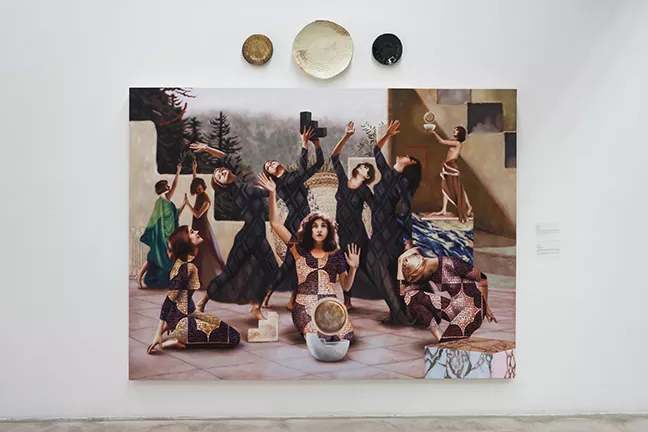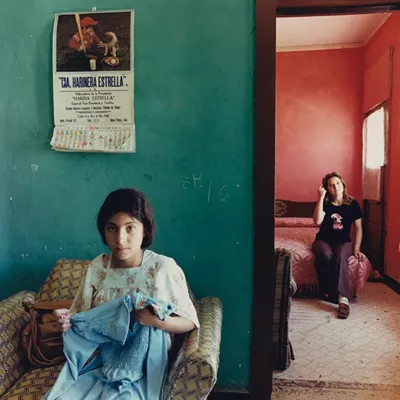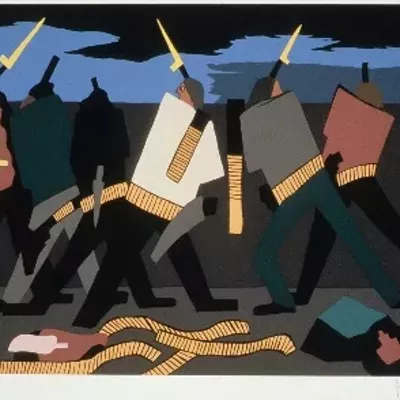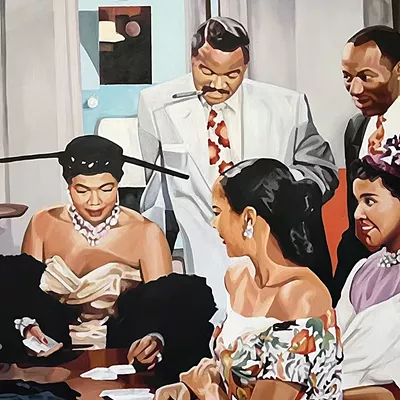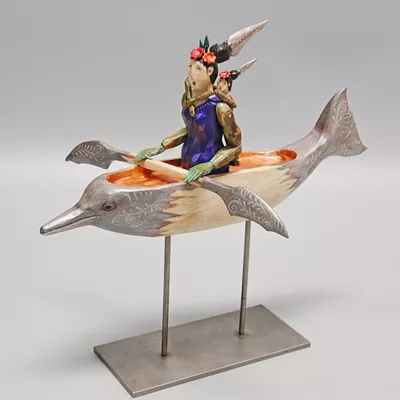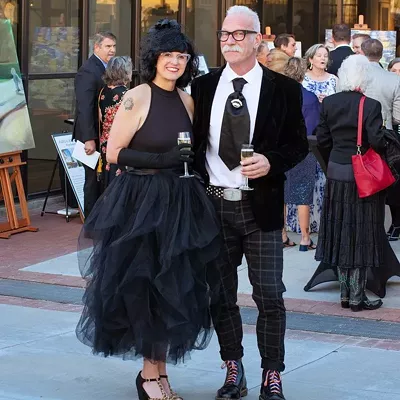One of the first things you see—and hear—when you go into MOCA's Blessed Be show is a giant black box from which human screams are emanating.
If you walk inside the box, as I did, tentatively, you'll be blinded by the darkness. You will see neither walls nor a path. You won't know where to turn. And you'll hear the ungodly shrieks.
Luckily for me, MOCA director and curator Ginger Shulick Porcella turned up to guide me back to the light.
Shulick told me that the physical installation—and the screams—came out of a performance piece by the artist Cassils, who uses only one name and goes by the pronoun "they." The recorded screams inside the box are theirs.
Four vivid color photos on the far side of the box document the performance, with a nearly naked Cassils grappling with monstrous gray sculptures. The artist is strong and abundantly muscled, but they seem to be in fear.
The whole piece, black box, screams and photos and all, bears the chilling title "Ghost."
The work's powerful images of the body and the struggle briefly call to mind classical Greek and Roman sculptures of fighting gladiators and the like. But this piece, and most of the others in the show, are not part of the usual western canon.
The gripping art that the exhibition's 19 artists have made—some of it disturbing, some contemplative—comes out of an alternate world, one evoked by the show's subtitle: Mysticism, Spirituality, and the Occult in Contemporary Art.
In a catalogue essay, Porcella writes that she has had a "lifetime fascination with ritual" and "cult mentality."
"There's a thriving scene of occult artists today," she says. "People in troubling times look to something else to change things."
Museums have become a kind of church, places of meditation and contemplation, she notes, but in this exhibition, "church" is not about institutional religion. Instead, Blessed Be dives into magic and witchcraft and the occult.
Like Cassils' black box, many of the pieces are wild. And scary.
The projected face of a dead woman glows on a real coffin in one work and, in another, bloody toilet paper, remnant of a healing ritual, hangs from the wall like a Buddhist paper prayer. Both are by Genesis P-orridge.
Magic squares and words invoke demons and angels on carved and crumbling frescos by Christopher Carroll. A blood-red Jesus rises from the dead in a dye piece by Barnaby Furnas. And a massive panel of carved wood by Matthew Day Jackson has been blackened and scorched by fire.
"It's like the dark side of the moon," Porcella comments. "The moon was an important part of pagan practices."
Wildest of all is what you might call a demon room. Tucson performance artist Adam Cooper-Terán collaborated with Steven Johnson Leyba on a multi-media installation, "Invokation ov Reckoning: A Curse on Your Corporate Masters."
"Invokation" is a sensory assault, like a walk into hell: a tumult of sounds and light coming from a continuously looping video; thick wads of paint everywhere; piles of medieval-looking books. A curse altar at center allows you to write out a curse against a target of your choosing and toss it in with the others. (Male patriarchy has been a common target, Porcella reports.)
Leyba, Porcella says, is part Mescalero Apache, part Jewish, and a reverend in the Satanic church. He and Cooper-Terán, a well-known local video and performance artist who will perform in the museum's Solstice Celebration Dec. 21, worked for 10 years on "Invokation," which is meant to be a "curse on Monsanto," the oft-criticized agrichemical giant.
But all is not turmoil in the exhibition. As Porcella wrote in her essay, "a connection to the divine is clearly present" in Rothko's famous Chapel and in works by other contemporary artists. And a number of pieces in Blessed Be are peaceful meditations that reach for the divine in the sky or in community.
Painter and ceramicist Alison Blickle, an artist who's part of a community of herbalists, witches and midwives, contributed two large, serene paintings of women quietly and capably performing rituals.
"Uncrossing," pictured here, features women in poses reminiscent of dances by Martha Graham, the great choreographer who delved into the mysteries of ancient myth. Blickle typically includes her ceramics in her installations, painting pure white vessels into the wall works and placing real pots above and below the paintings.
Elsewhere in the museum, she's set up a replica of her studio; it's a clean, clear diorama of ceramics, painted scrolls and words written in sigils, the language of magic.
Leo Villareal's mesmerizing "Signature of the Invisible" is a continuous loop of moving black-and-white images that evoke the night sky. The modern-day magic of tech wizardry keeps the images going, and an algorithm insures that none of the beautiful starbursts will ever repeat. Each image is as fresh and novel as a new moon.

